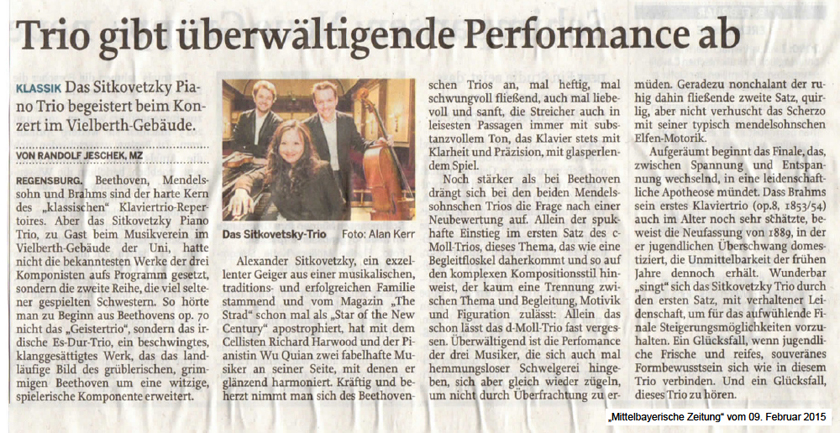Oberon's
Grove (April 25th, 2015)
All-Brahms @ Chamber Music Society of Lincoln
Center "This
evening's performance marked the Chamber Music Society debut of the Sitkovetsky
Trio. Although violinist Alexander Sitkovetsky has appeared with the Society before,
tonight marked his first performance there with his established chamber music
colleagues Richard Harwood (cello) and Wu Qian (piano). Their playing of the C-minor
trio drew a well-deserved, vociferous reception from the Tully crowd."
READ
FULL REVIEW? Lyn
Bronson, Peninsula Reviews (March 7th, 2015)
Sitkovetsky Piano Trio at
Sunset Center "The
evening’s program concluded with a many-faceted performance of Dvorák’s Piano
Trio No. 3 in F minor, and it was a knockout performance with extreme precision
and bold exciting playing by all three musicians. The Allegretto grazioso second
movement with its infectious cross rhythms provided many moments of charm, the
Poco adagio allowed us to hear more of the artistry of violinist Sitkovetsky and
cellist Harwood, and the final Allegro con brio was Dvorák at his best."
READ
FULL REVIEW? Mitteldeutsche
Zeitung (February 9th, 2015)
 TRIO
DELIVERS AN OVERWHELMING PERFORMANCE
Classical:
The Sitkovetsky Piano Trio thrilled at the concert in the Vielberth building By
Randolf Jeschek Regensburg. Beethoven,
Mendelssohn and Brahms are the hard core of the “classic” piano trio repertoire.
But the Sitkovetsky Piano Trio, guests at the Musikverein in the Vielberth building
of the University, did not play the most popular pieces of these three composers,
but the more seldom played “sisters”. So one heard, at the beginning of Beethoven’s
op.70, not the "Ghost trio" but the more down to earth E flat major trio, an animated
opus that, with its full sound, extends the common image of a brooding, fierce
Beethoven around a witty and playful component. Alexander
Sitkovetsky, an excellent violinist from a successful musical family and called
by “The Strad” a “Star of the New Century” has, in cellist Richard Harwood and
the pianist Wu Qian, two fabulous musicians at his side, with whom he harmonizes
brilliantly. The Beethoven was played with energy and power, sometimes vehement,
sometimes sparkling with energy, sometimes loving and tender. The strings, even
in the quietest passages, always had substance of sound and the piano was always
played with clarity and sparkling precision. Even
more than in the Beethoven, one started to think about a “revaluation” of the
two Mendelssohn trios. The spooky beginning in the first phrase of the C minor
trio, sounding like an unimportant phrase, shows a complex style of composing
where it is not possible to distinguish between theme, accompaniment, motif or
figuration: it already leaves the D minor trio forgotten. The performance of the
three musicians is breathtaking. Sometimes they indulge themselves in unrestrained
revelry but restrain themselves again in order not to overload. The quiet-flowing
second movement was almost nonchalant before the scherzo, lively but always articulate,
with its typical Mendelssohn fairylike motor. The
Finale, changing between tension and relaxation, opened out in to a passionate
apotheosis. Brahms liked his first piano trio (op.8, 1853/54) so much that he
revised it in 1889. But it still has its youthful exuberance. The Sitkovetsky
Trio "sings" the first movement with restrained passion in order to hold increasing
opportunities for the heart-stirring finale. It’s a stroke of luck when youthful
energy, maturity and a superior sense of style are combined as in this Trio. And
a godsend to hear them." |